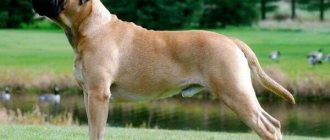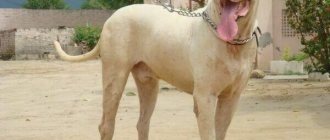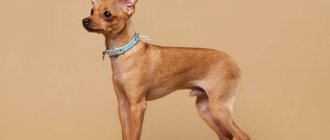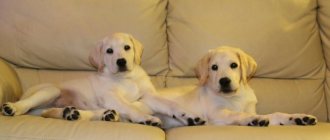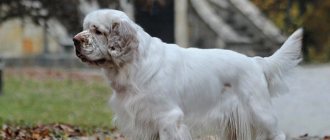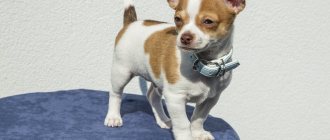The Rabbit Dachshund is the smallest breed of Dachshund in the world.
Bred for hunting in burrows, these cute and funny dogs are very popular as pets.
Of course, the hunting past affects the characteristics of their behavior and temperament.
But at the same time, rabbit dachshunds are suitable for apartment living.
They make wonderful companions.
Origin story
The dachshund is considered one of the oldest hunting breeds . Images of dogs similar to them can be seen on ancient Egyptian frescoes. However, calling them real dachshunds, of course, would be wrong.
Dachshunds in their usual appearance - with a highly elongated body, short legs, long ears and a rather thin tail - appeared much later in Europe.
Germany is considered to be the homeland of these dogs, where they have long been bred and used mainly for burrow hunting..
At the same time, small, very dexterous and evasive individuals were especially valued, which could easily slip into any, even the narrowest hole and, passing through underground passages, drive the animal out, under the shots of hunters.
Attempts to breed very small dachshunds have been made since the appearance of these dogs, however, targeted breeding of a smaller variety began only at the beginning of the 20th century.
Before this, the appearance of such puppies in litters of standard dogs was a happy accident for their breeder, since such animals were highly valued by hunters and cost much more than standard dachshunds.
Marriage or breed?
These dogs have remarkable hunting instincts and make excellent working dogs, used mainly for burrow hunting.
Rabbit dachshunds are also good as pets: they are smart, intelligent and playful.
Unlike many other breeds in which mini-dogs are considered a breeding match, the rabbit dachshund is one of three standard varieties, and therefore, with such a pet you can not only hunt or keep it as a companion, but also conquer the rings at the most prestigious exhibitions .
Combing
Smooth-haired dachshunds are always ready for a show. Their coat is always perfect, it does not require additional care or combing, and dirt does not stick to it. The same can be said about wire-haired dachshunds.
It is enough to clean these varieties sometimes with a brush, starting from the head and throughout the body in all directions.
Rabbit dachshunds with long hair look more decorative. They periodically need to comb the fur on their limbs, undersides and tail.
Brush dogs with a brush made of natural bristles, which is not capable of damaging the skin. Care should be taken to ensure that the hair behind the ears does not form clumps.
Long-haired breeds should be combed with a furminator - this device is ideal for caring for your pet during shedding.
The dachshund is sanguine by temperament and has a strong, stable character.
Description of the pet's character
The rabbit dachshund has a balanced, but at the same time energetic temperament . Friendly towards people, not aggressive, but at the same time, not fearful.
When hunting, she shows herself simply superbly, as she is courageous, purposeful and agile.
At home she is friendly, affectionate and gets along well with children. In addition, the rabbit dachshund is hardy enough to go on a long trip or hike with its owners.
She is mobile, active and just loves to run and play outdoors..
The rabbit dachshund can be a wonderful playmate for children, but adults need to ensure that the child does not tease the dog or play games with it that provoke aggression.
Purpose
Dachshunds are hunting dogs designed to hunt foxes and hares, as well as burrow-dwelling beavers, badgers and otters. Among hunting dogs, dachshunds are the smallest, but the most courageous and confident. Since ancient times, many hunters are satisfied with the choice of the smartest breed of dachshund dog. Climbing into a hole, the dachshund fights in a dark and narrow hole, relying only on itself, knowing that the owner will not be able to help. It is also common for dachshunds to hold prey in a hole until the owner opens the hole.
Breed standard
A strong and muscular short dog with a strongly elongated body.
The rabbit dachshund has a high-set neck, a deep and fairly long chest with a well-defined “keel” characteristic of this breed, a straight and level back, and a slightly sloping croup..
The head is long, dry, wedge-shaped. The transition from a flat forehead to an elongated and slightly hook-nosed muzzle is weakly expressed. The lips fit tightly to the gums, the jaws are strong, and the mouth is quite deep.
The nose is black, but in brown dogs brown is also acceptable.
The eyes are dark brown, oval, medium size, slightly slanted.
The ears are quite long, mobile, with rounded ends, with the leading edge fitting tightly to the dog’s cheekbones.
The limbs are straight, shortened, but do not look disproportionate. Quite strong and muscular, with the hind legs set slightly wider than the front ones.
Marking is considered a serious defect in rabbit dachshunds, for which animals are severely fined at exhibitions.
The tail is not particularly thin, but not thick either, slightly saber-shaped, tapering towards the end. Usually, it is lowered or raised no higher than the line of the back.
Expert opinion
Kozhevin Semyon Kirillovich
Expert dog handler.
“The rabbit dachshund very successfully combines the features of a large dog and small size. She has a strong character, a brave heart and high intelligence. The pronounced individuality of the rabbit dachshund, its self-confidence, determination and courage, make these dogs respected and taken into account. She is devoted to her owner and truly loves him, but at the same time there is not a shadow of ingratiation in her behavior.”
Owner reviews
Many owners are delighted with their little dachshunds . But everyone notes that it will take a lot of patience, endurance, and understanding to raise a “law-abiding” dog, because punishing a dachshund is not recommended. Along with intelligence, the dog is characterized by rancor, cunning and vindictiveness.
Important! Finding a common language with your pet and not allowing him to imagine himself as the leader of the pack is not easy. But if this works out, then a person will not find a better, more faithful and more loyal companion.
They also note that the dachshund can be picky when it comes to food, it will sleep where it decides (most often in the owner’s bed, where it is warmest), and ask for walks every 2 hours, even if it goes to the toilet in the cat’s litter box. But there is so much sincerity and loyalty in her behavior, how much joy she brings to those who devote the proper amount of time to her - that is, of course, all the time that the owners have.
Return to content
What is the difference from the standard fee? How is it different from dwarf?
Rabbit dachshunds are not much different in character from other dogs of this breed, except perhaps a little more active and energetic.
External differences lie solely in size : a rabbit dachshund is approximately two to three times lighter than a standard dachshund, weighing about 9 kg, and weighs about a third less than a dwarf or, in other words, miniature, whose weight is from 4 to 5, 5 kg .
Often, rabbit dachshunds grow to almost the same size as miniature ones, which is why only a specialist can determine which size variety a particular dog belongs to.
Basic colors
Main colors of rabbit dachshunds:
- Black and tan.
- Ginger.
- Brown and tan.
- Brindle.
- Marble: black marble or brown marble.
For the wire-haired variety of the dwarf dachshund, boar coloring is also acceptable, which is considered a disadvantage for dogs with a different type of coat.
Advantages and disadvantages
pros:
- High intelligence and intelligence.
- Friendly and sociable disposition.
- Cheerful and playful.
- Expressive and funny facial expressions.
- They get along well with children if they take into account their interests.
- Quite a long lifespan.
- Hardy and energetic.
- Excellent hunting dogs when working on burrowing animals.
- Rabbit dachshunds, thanks to their courage and alertness, make good guards.
Minuses:
- Representatives of this breed often have problems with the spine and other diseases typical of all dachshunds.
- If not fed properly, obesity can occur.
- They love to rummage in the ground, which is why they destroy the garden beds and flower pots in the house.
- They love to bark at other people's dogs, and some rabbit dachshunds even enter into battle with them, regardless of the size of the enemy.
NOTE!
Like most hunting dogs, dwarf dachshunds can be stubborn and willful, which is why they refuse to obey their owners' commands.
Training
Dachshund training begins as early as possible. Some rules that will help raise a dachshund:
- Before showing what to do, you must say a command.
- Don't distract your dog while executing the command.
- Do not give the treat until the dog has completed the command.
- Always pronounce commands in the same tone and clearly formulated.
Before teaching a dog commands, it is necessary to formulate principles of education, such as:
- Teach the dog its name.
- Train him to use a collar and leash.
- Toilet and outdoor training.
- Get used to your absence.
Coat types
- Smooth-haired. The coat does not exceed 1 cm in length, smooth, close to the body, not rough. The undercoat is also short, soft, but not fluffy.
- Long-haired. On the body, limbs and ears, the hair is wavy, thick and quite long - from 5 to 10 cm. On the head it is short, smooth and close-fitting.
- Wirehaired. The coat is short - up to 3 cm, wiry, thick and dense. On the face it forms eyebrows, mustache and beard, typical for this variety.
Life expectancy, illness and health
How long do dachshunds live? The average life expectancy of these dogs is 13 years.
Rabbit Dachshunds may be predisposed to the following diseases:
- Swimmer's syndrome.
- Spinal diseases.
- Epilepsy.
- Dental problems.
- Atlanto-axial instability.
- Hydrocephalus.
- Skin diseases.
- Hypoglycemia.
- Endocrine diseases.
- Cataract.
- Tendency to obesity.
CAREFULLY!
Due to their small size, rabbit dachshunds are at increased risk of injury.
To avoid possible health problems for your pet, you should not allow him to jump from high surfaces, and it is better to carry him down stairs.
What not to do with miniature dachshunds
Precautionary measures will not be superfluous when dealing with dachshunds of any size:
- Jumping even from a small height should not be allowed. This is very dangerous for the dachshund's spine.
- Do not lift a Dachshund puppy or young dog by the scruff of the neck or by holding it under the front paws. This negatively affects the position of the animal's elbows.
- Until about a year old, the dachshund should not be allowed to go down the stairs on its own. During the formation of bones and muscles, even a small load can affect the spine, the shape of the limbs, muscles and joints. When going out for a walk, it is better to hold the dachshund in your arms.
- Don't overfeed. Excess weight is an inherent problem in the breed, causing serious illness and shortening lifespan.
Basic rules of care
A smooth-haired rabbit dachshund only needs to be brushed from time to time..
In addition to periodic combing, a long-haired dachshund may also require haircuts once every six months, especially if the pet is a show pet.
And for a wire-haired dog, in addition to combing with a brush, trimming will be required, which should not be replaced with a haircut.
It is necessary to inspect your pet's ears and mouth every day, but cleaning them daily is not recommended . It’s better not to poke into your dog’s ears unless necessary, since even a cotton swab can easily injure the ear canal.
The eyes are cleaned with a damp cotton swab as they become dirty.
If necessary, claws need to be trimmed with special nail clippers, but it is better to give preference to guillotine-type nail clippers .
Make sure your dachshund rabbit always has toys or chew treats to clean his teeth with.
Place in the pack
The nature of a dog helps the owner feel like a family. The genetic “memory of ancestors” forces wild and domestic dogs to strive to take the place of the leader, protecting the members of the pack and helping them survive.
By default, the owner occupies this warm place, but the dog strives to test the person from time to time. Is he worthy of such an honor?
The passion to challenge and challenge leadership appears in a pet at the age of 4-6 months. Dogs demonstrate rivalry by refusing to follow commands and by insisting on climbing onto the sofa or bed, even though it is forbidden. Less often, growling when wiping their paws after a walk or at the owner approaching a full bowl of food. A few bite slightly.
It is wrong to be afraid of this, to be afraid in the future to regularly encounter the insolence and aggressiveness of a pet.
A dog does not rebel if it perceives its owner as a calm, self-confident person, fascinated by it, caring, guiding with leadership pressure.
It is advisable to raise a growing puppy with the whole family. Pets should practice basic commands with the dog. In the little mind of the puppy, the picture will form that in this pack he is almost an equal. But he must be smart, and also - she already has the best leader in the world.
How to feed
Rabbit dachshunds love to eat, which sometimes has a negative impact on their appearance and health, as they are prone to obesity.
In order not to overfeed the pet, the owner should not treat him with food from his table, no matter how touchingly the dog looks at him.
These dogs can be fed either a natural diet based on meat with the addition of cereals, vegetables, herbs and dairy products, or ready-made food.
Purchased food must be appropriate for the size, age and health of the pet..
It is very important that the food is of good quality and fresh. It is unacceptable to feed a rabbit dachshund the remains of food it has not eaten before; it is imperative to prepare a new portion of food for it.
Nutrition
The puppy's diet should be balanced. These dogs are prone to obesity and need careful monitoring of their diet. The daily diet should include:
- Meat - beef, chicken, turkey, lean lamb.
- Vegetables and fruits - carrots, tomatoes, zucchini, stewed cabbage, rarely potatoes, apples.
- Cereals - buckwheat, rice, oatmeal, boiled in meat broth.
Note! Dachshunds are recommended to use tendons and cartilage, which strengthen the jaw and clean the teeth.
Popular nurseries
- Golden Daxhund, Moscow region, Odintsovo
- From Omsk Fortress, Omsk
- Caladium Vis-a-vis, Moscow
- Caroline Yudzhel, Moscow
- Kinchville, Moscow
- Fox Nose, St. Petersburg
- Minidogland, Smolensk
- Myshkin House, Moscow
- Magic Rainbow, St. Petersburg
- Norden Licht, Moscow
- Rus Bramers, Moscow
- From the Marvelous Mountains, Krasnoyarsk Territory, Divnogorsk
- Stayer's, Tula
- Formula for success, Moscow
- Certus, St. Petersburg
You can easily find the websites of these nurseries on the Internet, as well as the coordinates of their owners.
How to choose a puppy?
People who decide to buy a rabbit dachshund should not rush to purchase a pet, since the breed is currently quite popular and a lot of puppies are born.
It must be remembered that only a good reputation of a kennel or breeder is a guarantee of the quality of the purchased dog..
At the same time, no one will be able to give a guarantee until the dog reaches adulthood whether it will turn out to be a rabbit or will grow into a miniature one.
The puppy itself should look strong, cheerful and well-fed . He should have clear, clean eyes, a coat without bald spots, no signs of rashes on the skin and no discharge from the nose or ears.
The puppy you buy must have documents and come from a line known for health and good mental health.
Vaccinations
Before vaccinating a puppy , deworming should be carried out, since vaccination is more difficult for infected animals to tolerate. Regular pyrantel will do.
The first vaccination can be carried out at 1.5 months. This could be a vaccination against hepatitis or enteritis - it all depends on the prevalence of diseases in the region of residence.
Puppies tolerate such vaccinations , but it is better not to take them outside yet. Two weeks later, a second course of the selected vaccine is administered.
At 2.5 months it is time for the plague vaccination. There is no point in doing it earlier, and delaying it further is dangerous for the dog’s teeth
The fact is that vaccination against plague affects the growth of teeth, which begin to change later, when the vaccination is left behind.
After this procedure, for 3 weeks, it is better not to walk the puppy in public places, protect it from hypothermia and not bathe it.
A second plague vaccination is given at 6-7 months - just after changing teeth.

